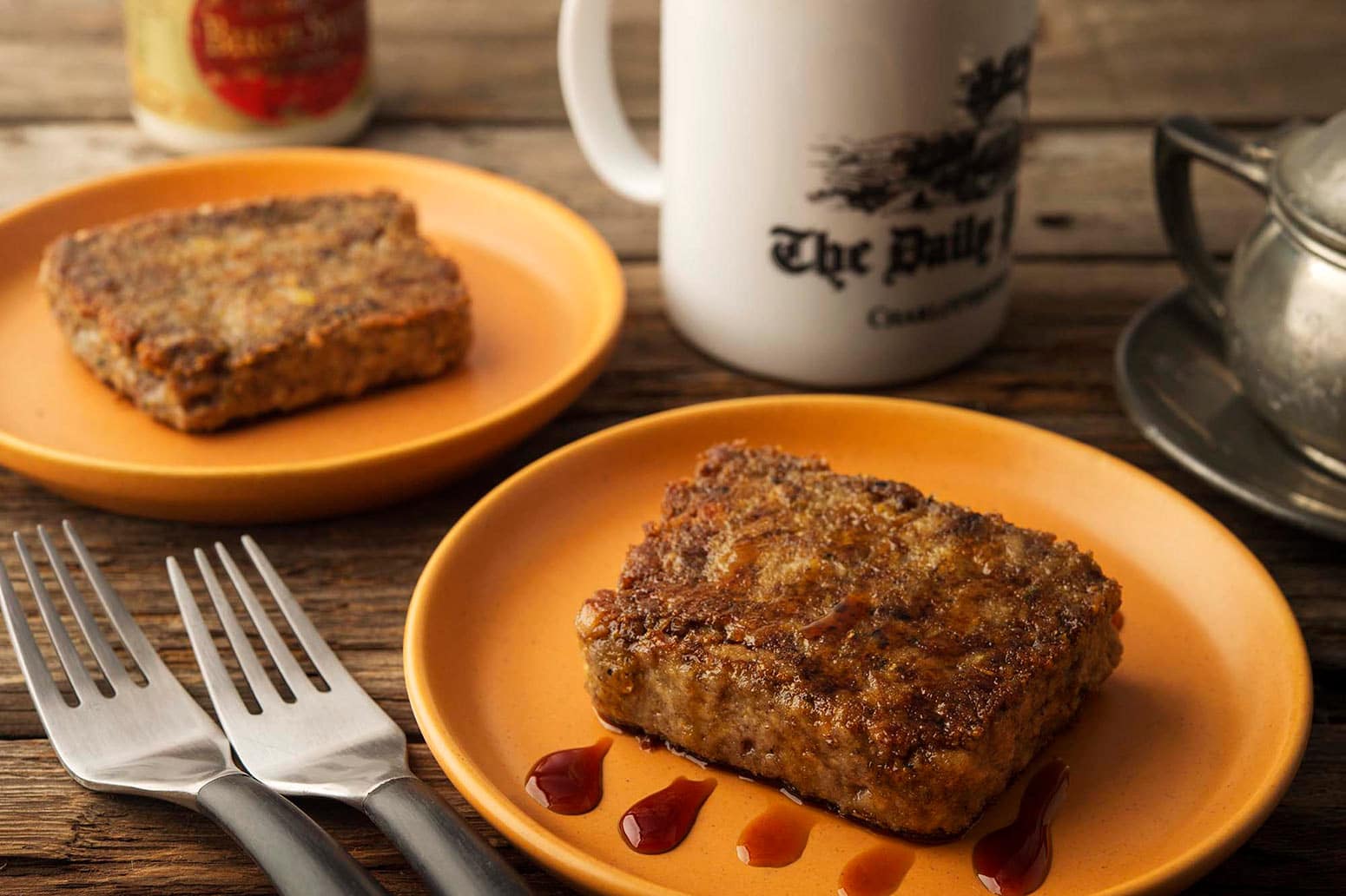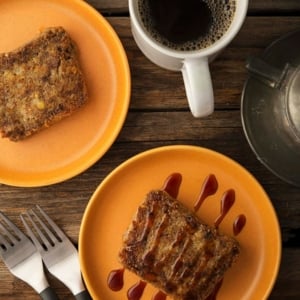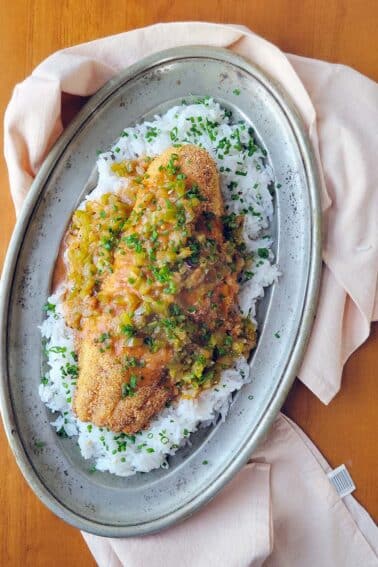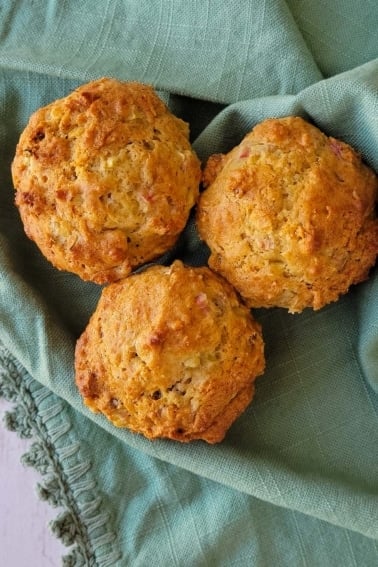As an Amazon Associate I earn from qualifying purchases.

Scrapple. Mystery meat. Lips and, well, scraps. Scrapple is scorned by many, loved by those who know.
Yes, industrial scrapple literally used to be made from scrapings off the killing room floor. Ew. But any homemade scrapple recipe uses bits that are far more wholesome.
First off, what is scrapple? It is a hybrid meatloaf-sausage common in the mid-Atlantic states, notably Delaware, Maryland and Pennsylvania, but I’ve eaten it as far west as Peoria, Illinois. It’s there that I first had scrapple I liked.
I grew up in New Jersey, in the heart of Taylor ham country. Taylor ham is the single greatest breakfast meat ever made, but then I am biased. When you live in Taylor ham country, you look down on scrapple, so I never ate it as a kid. Then, one day, I ran a 10k road race in Peoria. Afterwards, I could eat anything I was so hungry. So I ordered the scrapple.
It was served with apple butter and maple syrup, and I could choose. I thought it weird, but then, I like maple breakfast sausages, so why not? And damn it if it wasn’t tasty!
Scrapple tastes meaty and porky, peppery with warming spices and that softness you get from good polenta. Good scrapple is very crispy on the outside, soft in the center.
Flash forward some time, and I found myself with a pig’s head. This an oddly common occurrence in my household.
I’d already made a fantastic pozole with one head, as well a French fromage de tete and an Italian version of head cheese, so I was looking for something to make that was different. Why not make scrapple?
Scrapple recipes are all over the map. Southern versions use only pork and cornmeal, but mid-Atlantic ones use buckwheat flour, too. In Ohio, you see goetta, which uses oats. This is a Pennsylvania-style scrapple.
A truly authentic scrapple recipe use a pig’s head, and that’s what I used here. But you need not go that far if you really love scrapple. You can make it with any assortment of random pig bits. But keep in mind that scrapple has to bind to itself, so you want that collagen that is in a pig’s head.
You could sub in pig’s feet, or even use a sheet of unflavored gelatin in a pinch.
Scrapple takes time to make, so make your scrapple on a weekend or day off. It also needs to rest overnight in the fridge to set up. Once made, however, scrapple will keep for a week in the fridge, and it freezes well.
To serve, cut off thick slices from the loaf, dust in flour or fine cornmeal, then fry in butter, lard or bacon fat. Eat it solo, or with apple butter or a nice dark syrup.
Scrapple
Ingredients
FOR THE PIG'S HEAD
- 1 pig's head, with or without the jowls
- 3 carrots, chopped
- 1 large onion, chopped
- 3 to 6 bay leaves
- 1 tablespoon juniper berries, crushed (optional)
- 1 tablespoon black peppercorns, cracked
SPICE MIX
- 1 tablespoon freshly ground black pepper
- 1 tablespoon salt
- 1 tablespoon savory
- 2 teaspoons Bell's poultry seasoning (optional)
- 1 teaspoon dried thyme
- 1 teaspoon ground white pepper
- 1/2 teaspoon cayenne
TO FINISH
- 2 heaping cups cornmeal
- 1/2 cup buckwheat flour
Instructions
- Set the pig's head in a large kettle and cover it with water. Bring this to a boil and skim off all the scum that floats to the surface. When this is done, add the carrots, onion, bay leaves, juniper and black peppercorns. Simmer this, adding more water if the level drops below the pig's head, until the meat wants to fall off the bone, about 3 hours.
- Carefully remove the pig's head and pick off all the meat and random bits. I toss the eyes and the palate, which aren't very tasty. Chop everything up very fine, and combine with the spice mix in a bowl.
- Strain your pig broth and pour about 10 cups into a large pot. Bring this to a simmer and add the cornmeal and buckwheat flour, stirring constantly so you don't get lumps. Add salt to taste. Cook this, stirring often, about 30 minutes.
- Add the chopped pig bits in with the mush and stir well to combine. If you happen to be using the unflavored gelatin, now is when you would add it. Let this all cook for 10 minutes or so.
- Pour this into loaf pans, or a terrine pan. While not strictly necessary, it will make the scrapple easier to remove if you line the pan with plastic wrap first. Pack it in well. Let it cool to room temperature uncovered, then cover it with plastic wrap and refrigerate overnight before slicing and frying.
Notes
Nutrition
Nutrition information is automatically calculated, so should only be used as an approximation.






I make scrapple about once a year. I have never had or made scrapple that did not have liver in it. I usually use the heart and tongue also. When I bone out the hog, I put all the bones and head in the pressure cooker for about 1 hour. it will surprise you how much meat you get that you would have thrown away. A 250 Lb hog will usually render about 7 Qtrs. of meat that would otherwise be lost. It is a good choice in addition to the head for scrapple. I grow my own corn for the meal. I use Bloody Butcher for all my corn meal recipes. For those of you that never heard of it, it is an old heirloom breed of field corn that has a very deep blood red color. Superior corn flavor. Anybody out there that is thinking of making scrapple, don’t leave out the liver. Any cornmeal will work but real home ground meal is much better for flavor.
This looks like a delicious recipe, but…!!
I come from Maryland and scrapple is sold in the stores there
I don’t have access to a whole pig’s head.
I have made scrapple a few times because I m looking for.now live in Minnesota and they don’t sell scrapple in the stores here. The recipe I found calls for pig neck bones and they work well.
For flavor, I use only summer savory and it is the taste I a
A question: I can easily acquire pig’s feet, but I’m not so sure about a head. How many trotters would you use as a substitute for a pig’s head? And would the cooking of them be significantly different? (I’m dying to try this.)
thank u for the recipes
we make a form of this recipe every year after butchering
love the idea of carrots & ect. in brine .
will have to try this !
81 years as a Jersey Girl. Taylor Pork Roll, not Taylor Ham!
Love homemade scrapple.
Dona: Taylor ham. Period. 😉
You are correct! Pork Roll is, in fact, correct! Haha.. at least that’s how the state of PA always referred to it. And it’s delicious! But not in the same neighborhood as our beloved Scrapple 😉
Taylor pork roll! love scrapple.thanks for the recipe.
Wish I had the stomach to make this! Definitely have the stomach to eat it though lol! Had homemade scrapple a few years back and could not get enough of it.
This recipe brings me back to working with my Dad at butchering time. Scrapple was a “found meat” recipe Dad made at the very end of butchering and every batch tasted slightly different. We couldn’t scrape our pigs so always had to skin them but Dad made sure to save some of the best and thickest skins if he could. (Dad had an old Norelco electric shaver he used for getting this bristles off.) Otherwise, it was one big kettle of bones, including anything meaty we had butchered, well cleaned pig and/or chicken feet, well cleaned pig head, organ meat we otherwise didn’t use (including beef, venison, pork, and chicken if we’d done any.), two or three lbs of halved onions and a head or two of garlic, slow simmer until the meat fell off the bones, strain out the meat, pick it over for small bones, strain the broth through cloth and save, grind the meat fine, mix broth with slow cook oats until glutinous, mix in meat and seasonings, pack into loaf pans (We had two dozen aluminum loaf pans we only used for scrapple.), bake at 350 degrees Farenheight for thirty minutes, cool overnight and wrap for the freezer. Because my Dad hunted, we used a lot of venison bones in the mix; some batches were half venison! Any remaining broth was pressure canned for use during the winter; we usually had a dozen quarts or so. I didn’t like my Dad’s scrapple much; it always tasted too much like quick oats for me. I know why he used it; senior nutrition programs were always dumping it on us because we were some of the few who would take it at all. (My sister would get some through some disabled nutrition program; she saved a container or two for her baking and passed the rest on to us.) I haven’t had homemade scrapple in nearly seven years since Dad grew too sick to make it before he died. I still find myself with saved bones in the freezer intending to make some, but they usually end up being cooked up for a quart ot two of stock. I need a bigger freezer compartment or maybe just a small freezer…